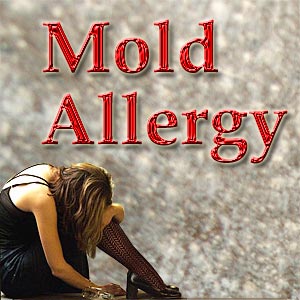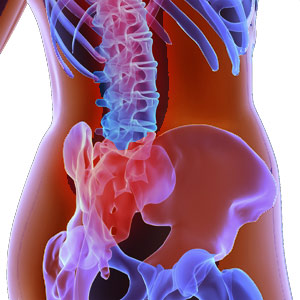Mold Allergy

Mold is an organism that is present in most places, either indoors or outdoors. Scientifically, mold is defined as a type of fungus that has the ability to break down dead material and return nutrients to the environment. Mold is often visible on the food's surface in the form of green spots, as with bread. It literally grows with roots penetrating inside the food.
Mold needs food and water to thrive unlike plants. Mold thrives by digesting plant or animal matters such as leaves, paper, wood, dirt and food, often a form of carbohydrate material. Mold grows in moist dark spaces including basements, garbage cans and rotten leaves. It spreads in the form of tiny spores which are lightweight and travel in air.
Causes of mold allergy
It is possible to develop an allergy to mold if a family history of allergies exists. Being allergic to one type of mold does not necessarily mean being allergic to another type as well. However, there are some common molds that can cause allergies. They include alternaria, aspergillus, cladosporium and penicillium.
Symptoms to mold allergy worsen due to occupational hazards as is the case with farming, dairy work, logging, baking, mill work, carpentry, wine making and furniture repair. In these occupations the mold exposure is high and therefore chances of mold allergy is also high.
Mold can grow in basements, behind wall frames, damp surfaces, carpet pads and carpets. Exposure to such household mold can trigger mold allergy symptoms. Working in a building with seepage and leaky pipes, flood damages can cause mold allergy. Mold as such flourish in moisture along with other common allergens including dust mites and cockroaches.
A poorly ventilated house with tight windows and sealed doors can trap the moisture indoors creating ideal condition for mold growth. Damp areas such as bathrooms and kitchens are most vulnerable.
Mold allergy symptoms
Mold allergy symptoms vary from one person to another and range from mild to severe. Some may experience symptoms all year round while in some others symptoms would flare up only during certain seasons of the year. Symptoms are significant when the weather is damp, and when indoor or outdoor spaces have high mold concentrations.
The immune system of the person with respiratory mold allergy overreacts while breathing. This leads to several other allergy symptoms such as cough, itching of the eyes, and asthma. In some exposure to certain molds can cause very severe asthma attacks. Other common persistent symptoms include:
- Sneezing
- Postnasal drip
- Itchy nose and throat
- Stuffy nose
- Watery eyes
- Sinusitis
Molds that cause allergies
Although there are thousands of molds, only a few are available for allergy testing. Following are the most common mold spores found in the air that can cause potential mold allergy:
- Alternaria is a common outdoor mold and this is associated with severe asthma.
- Cladosporium is an airborne outdoor mold
- Aspergillus can be found both indoors and outdoors and is associated with allergic bronchopulmonary aspergillosis.
- Penicillium is yet another outdoor mold associated with antibiotic allergy.
- Helminthosporum is commonly found in warmer climates.
- Epicoccum is found in grassland and agricultural areas.
- Fusarium is found in rotten plants.
- Aureobasidium is another common outdoor mold found in paper, lumber and painted surfaces.
- Phoma is an outdoor mold common during wet periods.
- Smuts is found in agricultural areas
- Rhizopus and Mucor occur on decaying leaves and damp indoor areas.
- Yeasts are found in the air during wet seasons and in agricultural areas.
Treatment for mold allergy
Food should be properly refrigerated as stale food can become an important source for mold growth. It is essential to control the humidity level of the work place. Dehumidifiers can help solve the problem to some extent in case of extreme humidity. Use products that are allergy reduced at a personal level.
Perhaps the best defense against mold allergy is to reduce exposure to the types of mold that can cause possible reaction. Normally in colder climates molds can be found in outdoor air in late winter and peak summer to early fall months. In winter climes mold spores are found throughout the year and the highest levels found in late summer to early fall months. Indoor molds can occur year round. This is dependant on the moisture levels in the home. Indoor mold levels are higher when outdoor mold levels are higher.
Although it is not always possible to avoid mold allergy triggers, there are certain medications/ treatment options that are available to keep mold allergy under check. Corticosteroids are generally the first step of the medication given to people with mold allergy. For instance, the inflammation caused by mold allergy can be treated with nasal corticosteroids. Fluticasone, propionate, memetasone, becalomethasone are some of the corticosteroids available in the market.
There are antihistamines that come in handy for those suffering from irritation of the nose or itching, sneezing and running noses. Azelastine is one such nose spray which works well as an antihistamine. Similarly, decongestants like phenylephrine and oxymetazoline are used for people suffering from mold allergy. But it is absolutely necessary to use these medications only with the concurrence and advice of a doctor.
Immunotherapy is another form of treatment for mold allergy. This again should be taken only under the guidance of a medical practitioner. The medical history and the health of the patient are taken into consideration before going ahead with the treatment. And immunotherapy has a lasting impact and provides long term relief from mold allergy.
There is also a home remedy for mold allergies. This simple treatment involves rinsing the victim's nose with saline water. The water should contain one fourth spoon of salt and two cups of warm water. It is necessary to understand that although mold allergy cannot be classified as a disease in itself, it can cause serious irritation and impair the ability to work normally.
Mold spores
These are seeds of molds and fungi. They grow in moist shades and in decaying leaves, compost piles, rotting wood and in barn
and stocks during harvest season. Although all mold spores are not allergenic inhaling some of them can cause allergies.
The primary symptom of inhaling a mold spore is allergic rhinitis or hay fever. Here the mucus membrane of the nose and sinus areas is inflamed. Sneezing, nasal discharge, nasal congestion, dry and scaling skin are common signs. When inhaled, the mold spores would reach the lungs and cause asthma. Sometimes the symptoms can last a whole year depending on its severity.
Mold spores symptoms worsen if food such as cheese, mushrooms, dried fruits, and food containing yeast, soy sauce and vinegar are consumed. These have the potential to cross react with mold spores resulting in worsening of the symptoms. And mold spore allergy is more likely if anyone in the family is allergic to airborne substances such as pollen and animal dander.
Although mold spore allergy cannot be cured, there are ways to prevent allergic reactions. Avoiding yarn work, lawn mowing, or raking leaves would help to some extent. Wearing a face mask outdoors should also help.
Black mold
Also known as mild dew or toxic mold, black mold belongs to the family of molds. They grow on surfaces in the form of powdery or
downy substance. The toxic mold grows on walls, wood, clothes, food, carpets and even articles made of leather such as a sofa, and even inside air conditioners, HVAC systems.
They can potentially cause severe adverse responses in human beings depending upon the type and quality that is present. Infants and elderly people exhibit a high level of risk when experiencing exposure to black mold.
A black mold after its formation needs nutrition to grow. This it obtains by degrading the surface it grows on. But during this process the mold causes formation of volatile organic compounds which are harmful to the human respiratory and nervous systems.
Dermal contact, ingestion and inhalation are some of the routes of exposure to this mold. Recent researches show some common symptoms of black mold poisoning include uneasiness in respiration, headaches, cough and red eyes, skin rashes, nausea, memory loss, bleeding in lungs in infants, lethargy, asthma, blood pressure, damaged respiratory and digestion systems, infections in urinary track and problems in urination, pain in liver and sometimes infertility in patients.
Mold control
- Since moisture is the most important contributing factor for growth of mold, ensure to keep the indoor humidity at about
50%. This is below the threshold where most molds flourish. Moisture can be monitored by using a hygrometer.
- Anti mold paints and products are as such available in the market these days which can help resist moisture at certain level.
- It is essential to correct any water leakage or intrusion, in the roof, gutter as well as plumbing and drainage leaks.
- It is imperative to ensure that air conditioners, HVAC systems and air and ventilation ducts are cleaned regularly. Mold formed
in these systems are quite dangerous and they can easily escape the human eye.
- Since basements are best breeding grounds for mold, it becomes necessary to use a low temperature dehumidifier to keep mold at
bay.
- Avoid using carpets in your basement. Instead use tiles for flooring.
- Bath mats should be washed thoroughly in very hot water on a regular basis.
- Avoid using carpets in your basement. Instead use tiles for flooring.
- Yet another area prone for mold formation is bathrooms. Ensure that tiles, curtains and appliances in the bathroom are properly cleaned and removed in order to avoid mold formation. Exhaust fans may be used in bathrooms and these fans can be switched on for ten minutes after bathing. Mold resistant shower curtains are also recommended.
- It is necessary to clean contaminated surfaces with chlorine bleach; use a protective mask and goggles when cleaning
- Ensure that house plants are limited and those present indoor are mold free. The other best option would be to live without house plants as they tend to have molds in the potting soil.
- Use vacuum and steam cleaners to maintain a clean house. Central vacuuming is a healthy way to remove all the dirt and reduce the indoor pollutants. Alternatively, a high efficiency disposable vacuum bag is the most effective and healthful way to collect particulates.
- Insulin materials used at home that have become wet should be periodically replaced with allergen friendly materials.
- It would be wise to heat all the rooms in the house during winter seasons to prevent mold growth. This is especially needed
for basements, where condensation is likely with cold walls and floors.
- In addition to the above, one can avoid foods that are likely to contain mold or other fungi such as yeast and mushrooms. Some other food sources of mold include cheese, mushrooms, vinegar and foods containing vinegar, meat and fish more than 24 hours old, breads, potatoes,
chocolate, sugar, raw vegetables and fruits, sauerkraut, pickles, dried fruits, refined grains, dairy, soy sauce, hot dogs and sausages and canned juices.
Top of the Page: Mold Allergy
Tags:#mold allergy #mold allergy treatment #mold allergy symptoms #mold allergy relief #mold spores allergy #black mold allergy
Stress Hives - Red itchy spots ...
Vitiligo Skin Disease - De-pigmented patches ...
Prickly Heat - Painful fallout of hot and humid summers ...
Narrow Band UVB - Used for skin conditions ...
Photodynamic Therapy - Combination of light and photosensitizing drugs ...
Mold Allergy - Reacting to mold spores ...
Latex Allergy - Reactions to soluble proteins in latex ...
Skin Fungus Infection - Itching and soreness ...
Eczema Treatment - Red, flaky skin, cracks or tiny blisters ...
Varicose Veins - Veins swell and rise above the level of the skin ...
Other health topics in TargetWoman Women Health section:
General Women Health

Women Health Tips - Women Health - key to understanding your health ...
Cardiac Care
Women's Heart Attack Symptoms - Identify heart problems...
Skin Diseases
Stress Hives - Red itchy spots ...
Women Disorders
Endocrine Disorder - Play a key role in overall wellbeing ...
Women's Reproductive Health
Testosterone Cream for Women - Hormone replacement option ...
Pregnancy
Pregnancy - Regulate your lifestyle to accommodate the needs of pregnancy ...
Head and Face
Sinus Infection - Nearly 1 of every 7 Americans suffer from ....
Women and Bone Care

Slipped Disc - Prevent injury, reduce pain ...
Menstrual Disorders
Enlarged Uterus - Uterus larger than normal size ...
Female Urinary Problems
Bladder Problems in Women - Treatable and curable ...
Gastrointestinal Disorders
Causes of Stomach Ulcers - Burning feeling in the gut ...
Respiratory Disorders
Lung function Test - How well do you breathe ...
Sleep Management

Insomnia and Weight Gain - Sleep it off ...
Psychological Disorders in Women
Mood swings and women - Not going crazy ...
Supplements for Women
Women's Vitamins - Wellness needs...
Natural Remedies

Natural Diuretic - Flush out toxins ...
Alternative Therapy
Acupuncture Point - Feel the pins and needles ...
Top of the Page: Mold Allergy
Popularity Index: 101,143

